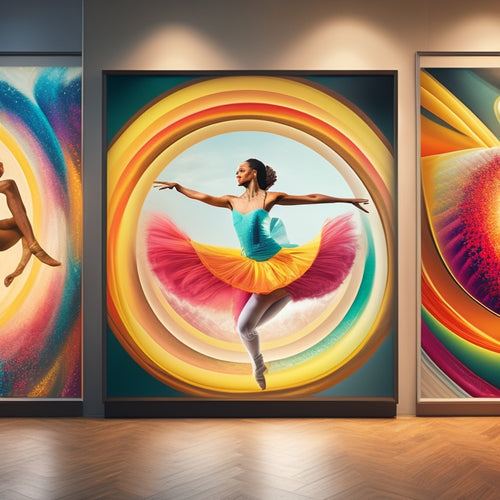
Baroque Dance Delights: Musical Rhythms Unveiled
Share
In the lavish world of Baroque dance, every step and melody was meticulously crafted to evoke grandeur and opulence. The deliberate rhythmic structures of 18th-century courtly entertainments reveal a harmonious relationship between music and movement, where composers and choreographers collaborated to create an artistic fusion of sound and motion. Historical treatises, such as the 1700 Chorégraphie publication, offer a window into this intricate symbiosis. By examining the intricate relationships between music and movement, we may uncover the secrets of this majestic art form and discover how the rhythmic revelations of music were mirrored in the dancers' movements. Further exploration awaits.
Key Takeaways
• Baroque dance is characterized by intricate relationships between music and movement, with deliberate rhythmic structures governing the dance floor.
• The 1700 Chorégraphie publication provides valuable insights into the rhythmic patterns and choreographed steps of 18th-century courtly entertainments.
• Composers and choreographers collaborated to create harmonious relationships between melody and movement, with rhythmic revelations of music mirrored in dancers' movements.
• The ornate world of Baroque dance was influenced by classical antiquity, elevating historical dance to an art form that fused music and dance.
• The symbiosis between movement and melody in Baroque dance reveals a unique art form that transcends boundaries between sound and motion.
Unveiling the Rhythms of the Past
As we explore the world of Baroque dance, the intricate relationships between music and movement come into sharp focus, revealing the deliberate rhythmic structures that underpinned the majestic courtly entertainments of 18th-century Europe.
Through historical investigation, we uncover the deliberate rhythmic patterns that governed the dance floor, where every step, gesture, and movement was carefully calibrated to the pulse of the music.
Rhythmic revelations abound as we investigate the treatises of the time, such as the 1700 Chorégraphie publication, which provides a window into the intricate relationships between music and movement.
Dance and Music in Harmony
One of the most striking aspects of Baroque dance is the intricate symbiosis between movement and melody. The rhythmic structures of the music inform and are, in turn, reflected in the deliberate, choreographed steps of the dancers. This harmonious relationship is rooted in historical connections, where composers and choreographers collaborated to create a unified artistic vision.
As a result, the rhythmic revelations of the music are mirrored in the dancers' movements, creating an artistic fusion that transcends the boundaries between sound and motion. Through rhythmic exploration, Baroque dance masters were able to craft an immersive experience that continues to captivate audiences today.
Step Into the Baroque Era
Delving into the ornate world of Baroque dance, we find ourselves transported to an era where lavish costumes, stately courts, and majestic palaces provided the backdrop for a highly stylized and refined art form. This was a time when historical dance was elevated to an art form, with intricate steps and movements carefully choreographed to harmonize with the rhythms of Baroque music.
The Baroque era was marked by a renewed interest in classical antiquity, influencing the development of dance forms such as the minuet and bourrée.
The ornate and intricate details of Baroque architecture and art also found expression in the elaborate costumes and sets of historical dance performances.
The fusion of music and dance during this period resulted in a unique and enthralling art form that continues to inspire and delight audiences today.
Frequently Asked Questions
What Is the Significance of the 1700 Choréographie Publication?
The 1700 Choréographie publication holds profound historical impact and cultural significance, as it codified the five basic positions of the feet and arms, establishing a standardized vocabulary for Baroque dance, influencing the development of Western classical dance.
Are the Dance Performances at Tryon Palace Open to the Public?
Regarding public access to dance performances at Tryon Palace, event tickets are typically required, ensuring a structured and intimate experience; however, it is essential to verify Palace Access and ticket availability in advance to guarantee admittance.
Can I Purchase Physical Copies of the Digital Downloads?
"Approximately 80% of collectors prefer physical copies. Fortunately, yes, you can purchase physical copies of our digital downloads, including Andrés Campra's compositions, in a Collector's Edition, boasting Archival Quality, perfect for connoisseurs seeking tangible, high-fidelity experiences."
Is Paige Whitley-Bauguess Available for Private Lessons?
Paige Whitley-Bauguess, a renowned dance expert, offers private coaching and dance mentorship, providing personalized guidance and expert instruction, fostering artistic growth and technical mastery in the field of Baroque dance.
Are Refunds Available for Digital Downloads?
Regarding refunds for digital downloads, our Return Policy guarantees digital safety, ensuring a secure and reliable transaction process, with clear guidelines for refunds and exchanges, fostering a trustworthy and liberated online experience.
Related Posts
-

3 Best Online Tools for Organized Dance Makeup Artists
You need online tools to streamline your workflow and deliver exceptional service to your dance clients. For seamless...
-

Top Performance Headbands for Fitness Enthusiasts
When you're looking for top performance headbands, focus on options that combine advanced moisture-wicking fabrics wi...
-

Dancers Delight: Stylish Wall Prints Available Now
Dancers Delight offers a curated collection of stylish wall prints that capture the essence of ballet, tap, and jazz,...


